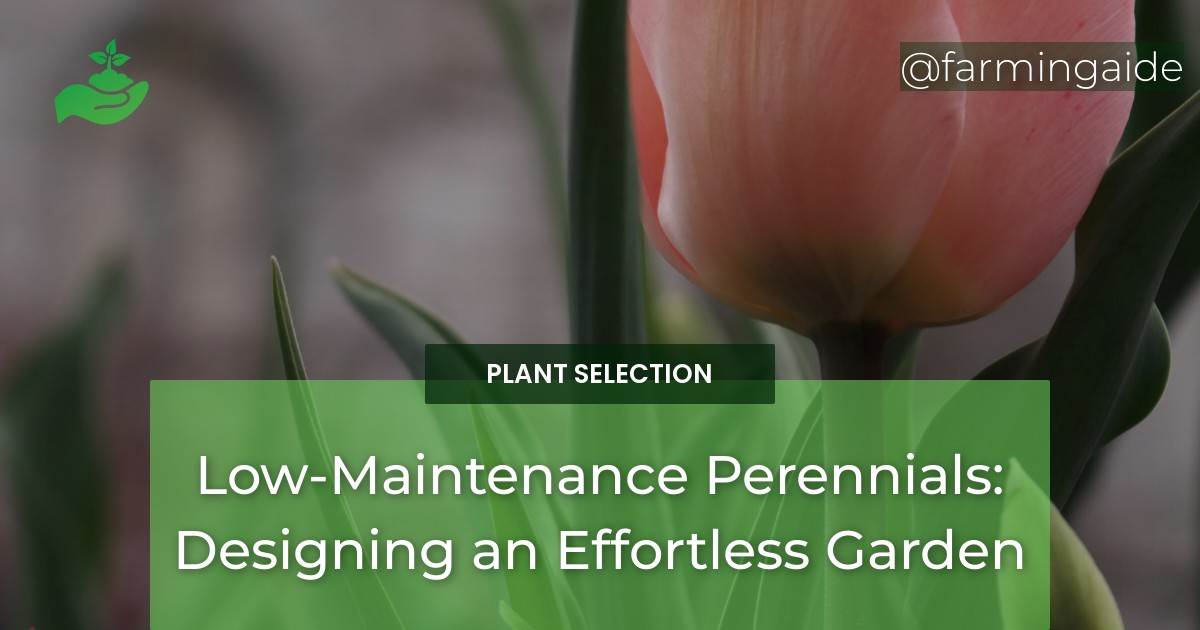Low-Maintenance Perennials: Designing an Effortless Garden
Benefits of Low-Maintenance Perennials
Low-maintenance perennials offer several advantages that make them a popular choice for gardeners:
Save Time and Money
By choosing low-maintenance perennials, you can save both time and money in the long run. Once established, these plants require less care, reducing the need for constant watering, fertilizing, and pruning.
Environmentally Friendly
Low-maintenance perennials are often native to their respective regions, making them well-adapted to local climates. This means they require less water, fertilizer, and pesticides, making them environmentally friendly choices for your garden.
Drought Tolerant
Many low-maintenance perennials have evolved to withstand periods of drought. These plants have deep root systems that allow them to access water even during dry spells, reducing the need for frequent watering.
Choosing the Right Low-Maintenance Perennials
When selecting low-maintenance perennials for your garden, consider the following factors:
Consider Your Climate
Choose plants that are well-suited to your local climate. Research the hardiness zones and ensure the plants you select can thrive in your region.
Determine Sunlight Needs
Some low-maintenance perennials prefer full sun, while others thrive in partial shade. Assess the sunlight conditions in your garden and choose plants accordingly.
Soil Type Matters
Take note of your soil type, whether it is sandy, loamy, or clay-based. Different plants have different soil preferences, so choose plants that are compatible with your soil conditions.
Think about Bloom Time
Consider the bloom time of the perennials you select. By choosing plants with staggered bloom times, you can ensure your garden remains colorful throughout the growing season.
ALSO READ
Top Low-Maintenance Perennials for Every Garden
Here are some popular low-maintenance perennials that can thrive in various gardens:
Purple Coneflower (Echinacea)
Purple coneflower is a hardy perennial with vibrant purple flowers. It attracts butterflies and requires minimal care.
Black-eyed Susan (Rudbeckia)
Black-eyed Susan is a cheerful perennial with bright yellow or orange flowers. It is drought-tolerant and can thrive in various soil conditions.
Daylilies (Hemerocallis)
Daylilies are known for their showy blooms and long flowering period. They are low-maintenance and can adapt to different soil types.
Blanket Flower (Gaillardia)
Blanket flower is a colorful perennial with red and yellow flowers. It is drought-tolerant and attracts pollinators.
Russian Sage (Perovskia)
Russian sage is a drought-tolerant perennial with silver-gray foliage and purple-blue flowers. It is a great choice for hot and dry climates.
Catmint (Nepeta)
Catmint is a low-maintenance perennial that produces clusters of lavender-blue flowers. It is attractive to bees and butterflies.
Yarrow (Achillea)
Yarrow is a hardy perennial with feathery foliage and clusters of flowers in various colors. It is drought-tolerant and easy to care for.
Tips for Caring for Low-Maintenance Perennials
While low-maintenance perennials require less care, they still benefit from some basic maintenance:
Watering
Water your perennials deeply but infrequently, allowing the soil to dry out between watering sessions. This encourages deeper root growth.
Fertilizing
Apply a slow-release fertilizer in spring to provide essential nutrients to your perennials throughout the growing season. Avoid over-fertilization, as it can lead to excessive foliage growth.
Pruning and Deadheading
Remove spent flowers to promote continuous blooming. Prune back any dead or damaged foliage to maintain the overall health of the plant.
Dividing
Some perennials benefit from occasional division to rejuvenate growth. Divide clumps every few years to prevent overcrowding and promote healthier plants.
ALSO READ
Designing an Effortless Garden with Low-Maintenance Perennials
To create a visually appealing garden with low-maintenance perennials, consider these design tips:
Group Plants with Similar Needs
Arrange your perennials in groups based on their water and sunlight requirements. This makes it easier to provide the right conditions for each plant.
Choose Complementary Colors
Select perennials with colors that work well together. Consider complementary color schemes to create visually striking combinations.
Mix Perennials with Shrubs and Annuals
Combine low-maintenance perennials with shrubs and annuals for added variety and interest. This creates a multi-layered garden with different heights and textures.
Consider the Height and Texture of Plants
Plant tall perennials at the back to create a backdrop, while shorter ones can be placed in the front. Mix plants with different leaf shapes and textures for a more dynamic garden.
Can Low-Maintenance Perennials also Attract and Support Butterflies in the Garden?
Yes, growing perennial butterfly gardens doesn’t have to mean high maintenance. Many low-maintenance perennials, such as coneflowers, black-eyed Susans, and Russian sage, can still attract and support butterflies in the garden. These beautiful plants provide food and habitat for butterflies while requiring minimal care from the gardener.
Final Thoughts
Designing an effortless garden with low-maintenance perennials allows you to enjoy a beautiful and vibrant outdoor space with minimal effort. Start by choosing the right plants for your climate, soil, and sunlight conditions. Incorporate various low-maintenance perennials, such as purple coneflower, black-eyed Susan, daylilies, blanket flower, Russian sage, catmint, and yarrow. Follow basic care practices, including proper watering, fertilizing, pruning, and dividing. When designing your garden, group plants with similar needs, choose complementary colors, mix perennials with shrubs and annuals, and consider the height and texture of plants. By following these guidelines, you can create a stunning low-maintenance garden that brings joy and relaxation.


